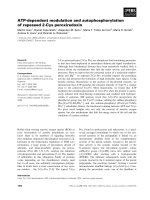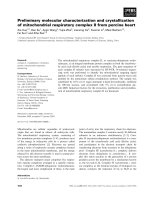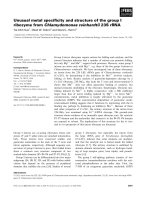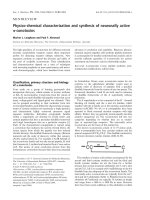Báo cáo " Anharmonic effective potential, thermodynamic parameters, and EXAFS of hcp crystals " docx
Bạn đang xem bản rút gọn của tài liệu. Xem và tải ngay bản đầy đủ của tài liệu tại đây (104.28 KB, 7 trang )
VNU Journal of Science, Mathematics - Physics 25 (2009) 213-219
213
Anharmonic effective potential, thermodynamic parameters,
and EXAFS of hcp crystals
Nguyen Van Hung
*
, Ngo Trong Hai, Tong Sy Tien, Le Hai Hung
Faculty of Physics, Hanoi University of Science, VNU
334 Nguyen Trai, Thanh Xuan Hanoi, Vietnam
Received 15 September 2009
Abstract. Anharmonic effective potential, effective local force constant, thermal expansion
coefficient, three leading cumulants, and EXAFS (Extended X-ray Absorption Fine Structure) of
hcp crystals have been studied. Analytical expressions for these quantities have been derived.
Numerical calculations have been carried out for Zn and Cd. They show a good agreement with
experiment results measured at HASYLAB (DESY, Germany) and unnegligible anharmonic
effects in the considered quantities.
1. Introduction
EXAFS and its parameters are often measured at low temperatures and well analysed by the
harmonic procedure [1] because the anharmonic contributions to atomic thermal vibrations can be
neglected. But EXAFS may provide apparently different information on structure and on other
parameters of the substances at different high temperatures [2-11,14,15] due to anharmonicity.
This work is devoted to development of a new method for calculation and analysis of the high
order anharmonic effective potential, local force constant, three leading cumulants, thermal expansion
coefficient, and EXAFS of hcp crystals. Derivation of analytical expressions for these quantities is
based on quantum statistical theory with the anharmonic correlated Einstein model [9] and Morse
potential is used to characterize interaction between each pair of atoms. Numerical results for Zn and
Cd are found to be in good agreement with experiment [16] and show unnegligible anharmonic effects
in the considered quantities.
2. Formalism
According to cumulant expansion approach the EXAFS oscillation function is given by [11]
()
+=
∑
Φ
−
n
n
n
n
ik
ikRe
e
kFk
ki
kR
kR
)(
!
)2(
2expIm)(
)(
2
)(/2
σχ
λ
, (1)
where )(kF is the real atomic backscattering amplitude,
Φ
is the net phase shift,
k
and
λ
are the
wave number and the mean free path of the photoelectron, respectively, rR = with
r
as the
______
*
Corresponding author. E-mail:
N.V. Hung et al. / VNU Journal of Science, Mathematics - Physics 25 (2009) 213-219
214
instantaneous bond length between absorbing and backscattering atoms and
σ
(n)
(n = 1, 2, 3, …) are
the cumulants [2].
The total mean square relative displacement (MSRD) or 2
nd
cumulant
(
)
T
2
σ
at a given
temperature T is given as the sum of harmonic
(
)
T
2
σ and anharmonic
(
)
T
A
2
σ contributions [11]
() () () () ()
[
]
,,
2
0
22222
σσβσσσσ −=+= TTTTT
AAtot
V
V
G
T
∆
= γβ 2)(
, (2)
where γ
G
is Grüneisen parameter, ∆V/V is the relative volume change due to thermal expansion,
2
o
σ is
zero-point contribution to
(
)
T
2
σ
.
The anharmonic effective potential can be expressed as a function of the displacement
0
rrx −=
along the
0
ˆ
R
direction, r and
0
r being the instantaneous and equilibrium bondlengths between
absorbing and backscattering atoms, respectively
()
3
3
2
0
2
1
xkxkxV
eff
+≈ (3)
where
0
k is effective local force constant, and
3
k is cubic parameter giving the asymmetry due to
anharmonicity. (Here and in the following, the constant contributions are neglected).
For calculation of thermodynamic parameters we use the further definition
a
x
y
−
=
,
0
rra −=
[9, 18], to write Eq. (3) as
() ( )
3
3
2
30
2
1
3 ykykayakkyV
effeff
+++≅
, (4)
where
eff
k is an effective local force constant, in principle different from
0
k .
Making use of quantum statistical methods [13], the physical quantity is determined by an
averaging procedure using canonical partition function Z and statistical density matrix
ρ
(
)
,3,2,1,
1
== myTr
Z
y
mm
ρ (5)
Atomic vibrations are quantized in terms of phonon, and anharmonicity is the result of phonon-
phonon interaction, that is why we express
y
in terms of annihilation and creation operators, a
ˆ
and
+
a
ˆ
, respectively
( )
eff
E
k
aaaay
2
,
ˆˆ
2
00
ωh
=+≡
+
, (6)
and use the harmonic oscillator state
n
as the eigenstate with the eigenvalue
E
nE
n
ωh=
, ignoring
the zero-point energy for convenience, here
E
ω
is correlated Einstein frequency.
A Morse potential is assumed to describe the interatomic interaction, and expanded to the third
order around its minimum
(
)
(
)
L+−+−≅−=
−
−
33222
12)( xxDeeDxV
xx
αα
α
α
, (7)
where α describes the width of the potential and D is the dissociation energy.
In the case of relative vibrations of absorber and backscatterer atoms, including the effect of
correlation and taking into account only the nearest neighbor interactions, the effective pair potential is
given by
N.V. Hung et al. / VNU Journal of Science, Mathematics - Physics 25 (2009) 213-219
215
() () ()
+
−+
−+=
+=
∑∑
= ≠
4
8
4
8
2
2
ˆ
.
ˆ
2
1
, ,
0
x
V
x
V
x
VxVxVxVxV
bai baj
ijeff
RR
, (8)
where the first term on the right concerns only absorber and backscatterer atoms, the remaining sums
extend over the remaining neighbors, and the second equality is for monoatomic hcp crystals.
In accordance with Eq. (4), using Morse potential Eq. (7), and
2
0
5 αDk =
the effective potential
Eq. (8) is expressed as
()
33222
4
3
10
9
1
2
5
20
9
15 yDyaDayaDyV
eff
ααααα −
−+
−≅ , (9)
where the local force constant is given by
B
E
EEeff
k
aDk
ω
θµωαα
h
==
−= ,
10
9
15
22
, (10)
where
E
θ ,
µ
are the correlated Einstein temperature and reduced mass, respectively.
For further calculation we write the effective interatomic potential as the sum of the harmonic
contribution and a perturbation V
δ
due to the weak anharmonicity
() ()
yVykyV
effeff
δ+=
2
2
1
, yyaDV
−≅
22
4
3
5 ααδ . (11)
Using the above results for correlated atomic vibrations and the procedure depicted by Eqs. (5, 6),
as well as, the first-order thermodynamic perturbation theory with considering the anharmonic
component in the potential Eq. (9), we derived the cumulants.
The 2
nd
cumulant or mean square relative displacement (MSRD) is expressed as
()
T
E
E
ez
D
z
z
T
/
2
2
0
2
,
10
,
1
1
2
0
θ
α
ω
σσσ
−
==
−
+
=
h
. (12)
First and third cumulants are
()
()
() ()
2
0
1
0
21
0
1
20
9
,
20
9
1
1
σ
α
σσ
α
σσ ==
−
+
=
z
z
T , (13)
()
()
()
( )
( ) ( )
()
( )
2
2
0
3
0
2
2
0
2
2
2
2
3
0
3
10
3
,23
10
3
1
101
σ
α
σσσ
α
σσ =
−=
−
++
=
z
zz
T , (14)
and Eq. (13) the thermal expansion coefficient is resulted as
()
( )
( ) ( )
RD
k
TRk
D
z
zz
B
T
B
TT
α
ασσ
α
αα
100
9
,
4
9
1
ln
0
2
2
0
2
2
2
3
2
2
0
=
−=
−
= , (15)
where R is the bond length,
(
)
(
)
3
0
2
0
1
0
,, σσσ
are zero-point contributions to
(
)
(
)
321
,, σσσ
and
0
T
α
is the
constant value of
T
α at high-temperature.
To calculate the total MSRD including anharmonic contribution Eq. (2) an anharmonic factor has
been derived
()
++=
222
2
4
3
1
4
3
1
8
9
σ
α
σ
α
σ
α
β
RR
T . (16)
The anharmonic contribution to the EXAFS phase at a given temperature is the difference between
the total phase and the one of the harmonic EXAFS, and it is given by
N.V. Hung et al. / VNU Journal of Science, Mathematics - Physics 25 (2009) 213-219
216
-1 -0.5 0 0.5 1
0
0.5
1
1.5
2
2.5
x (Å)
Effective potential V
eff
(eV)
Zn, Anharmonic
Zn, Expt.
Zn, Harmonic
Cd, Anharmonic
Cd, Expt.
Cd, Harmonic
0 100 200 300 400 500 600 700
0.01
0.02
0.03
0.04
0.05
0.06
0.07
0.08
0.09
T(K)
Anharmonic factor
β
(T)
Zn, Present
Zn, Expt.
Cd, Present
Cd, Expt.
()
−
+−=Φ
2)3(2)1(
)(
3
2
)(
11
2)(2),( kT
kR
TTkkT
AA
σ
λ
σσ
. (17)
We obtained from Eq. (1), taking into account the above results, the temperature dependent K-
edge EXAFS function including anharmonic effects as
[
]
( )
),()(2sin)(),(
)(/2)()(
2
2
2
2
0
22
TkkkRekF
kR
NS
Tk
j
A
j
k
j
RTTk
j
j
j
jj
A
H
Φ+Φ+=
++−
∑
λσσ
χ , (18)
where
2
0
S is the square of the many body overlap term,
j
N
is the atomic number of each shell, the
remaining parameters were defined above, the mean free path
λ
is defined by the imaginary part of
the complex photoelectron momentum
λ
/ikp
+
=
, and the sum is over all atomic shells.
3. Numerical results and comparison to experiment
Now we apply the above derived expressions to numerical calculations compared to experiment
for Zn and Cd measured at HASYLAB (DESY, Germany) [16]. Morse potential parameters of Zn and
Cd have been calculated by generalizing the procedure for cubic crystals [12] to the one for hcp
crystals. They are compared to the EXAFS experimental data [16]. Effective local force constants,
correlated Einstein frequencies and temperatures have been calculated using these Morse parameters.
The results are written in Table 1. They are used for calculation of anharmonic EXAFS and its
parameters. The calculated anharmonic effective potentials for Zn and Cd are compared to experiment
and to their harmonic components (Figure 1a). The calculated anharmonic factors for Zn and Cd are
shown in Figure 1b). They agree with the extracted experimental results [16].
Table 1. Calculated and experimental values of D,
α
,
o
r
, and
eff
k ,
E
ω
,
E
θ
for Zn, Cd
Bond D(eV)
α
(Å
-1
)
o
r
(Å)
)/( mNk
eff
)10(
13
Hz
E
×ω
E
θ (K)
Zn-Zn, Calc. 0.1698 1.7054 2.7931 39.5616 2.6917 205.6101
Zn-Zn, Expt. [16] 0.1685 1.7000 2.7650 39.0105 2.6729 204.1730
Cd-Cd, Calc. 0.1675 1.9069 3.0419 48.7927 2.2798 174.1425
Cd-Cd, Expt. [16] 0.1653 1.9053 3.0550 48.0711 2.2628 172.8499
a) b)
Fig. 1. Calculated anharmonic effective potentials and their harmonic components (a), and anharmonic factors
(b) for Zn, Cd. They are compared to experiment [16].
N.V. Hung et al. / VNU Journal of Science, Mathematics - Physics 25 (2009) 213-219
217
0 100 200 300 400 500 600 700
0.002
0.004
0.006
0.008
0.01
0.012
0.014
0.016
0.018
0.02
T(K)
σ
(1)
(Å)
Zn, Present
Zn, Expt.
Cd, Present
Cd, Expt.
0 100 200 300 400 500 600 700
0
0.005
0.01
0.015
0.02
0.025
0.03
T(K)
σ
2
(Å
2
)
Zn, Present
Zn, Expt.
Cd, Present
Cd, Expt.
0 100 200 300 400 500 600 700
0
0.1
0.2
0.3
0.4
0.5
0.6
0.7
0.8
0.9
1
x 10
-3
T(K)
σ
(3)
(Å
3
)
Zn, Present
Zn, Expt.
Cd, Present
Cd, Expt.
0 100 200 300 400 500 600 700
0
0.1
0.2
0.3
0.4
0.5
0.6
0.7
0.8
0.9
1
x 10
-5
T(K)
α
T
(1/K)
Zn, Present
Zn, Expt.
Cd, Present
Cd, Expt.
Figure 2 illustrates the temperature dependence of our calculated 1
st
cumulant (a) describing the net
thermal expansion and 2
nd
cumulant (b) describing Debye-Waller factor for Zn and Cd compared to
experiment at 77 K and 300 K [16].
(a) (b)
Fig. 2. Calculated temperature dependence of 1
st
(a) and 2
nd
(b) cumulants for Zn and Cd compared to
experiment at 77 K and 300 K [16].
Figure 3 demonstrates the temperature dependence of our calculated 3
rd
cumulant and thermal
expansion coefficient for Zn and Cd. They agree with the measured values at 77 K and 300 K [16]. All
three calculated cumulants of Zn and Cd satisfy their fundamental properties. They contain zero-point
contribution at low temperature as quantum effects. At high-temperatures the 1
st
and 2
nd
cumulants are
linearly proportional to the temperature T, but the 3
rd
cumulant to T
3
. Our calculated temperature
dependence of thermal expansion coefficients for Zn and Cd agree with experimental values at 77 K
and 300 K. Moreover, they satisfy Grueneisen theorem, where at low temperatures they behave as T
3
and at high-temperatures they approach the constant values as the form of specific feat.
(a) (b)
Fig. 3. Calculated temperature dependence of 3
rd
cumulants (a) and thermal expansion coefficients for Zn and Cd
compared to experiment at 77 K and 300 K [16].
N.V. Hung et al. / VNU Journal of Science, Mathematics - Physics 25 (2009) 213-219
218
Figure 4 shows the EXAFS spectra χk
3
calculated by our theory at 77 K, 300 K and 500 K (a) and
their Fourier transform magnitude at 300 K (b) compared to experiment [16]. The EXAFS are
attenuated and shifted shifted to the right as the temperature increases. Our calculated Fourier
transform magnitude agrees with experiment [16] and is shifted to the left compared to the harmonic
FEFF code results [1]. This is indicative of the necessity of including anharmonic contributions in the
EXAFS data analysis.
(a) (b)
Fig. 4. Calculated anharmonic EXAFS at 77 K, 300 K, 500 K (a) and Fourier transform magnitude at 300 K
compared to experiment [16] and to FEFF result [1] for Zn.
4. Conclusions
In this work a new method for calculation and analysis of anharmonic effective potential, effective
local force constant, three leading cumulants, and EXAFS for hcp crystals has been explored. This
anharmonic theory contains the harmonic model at low temperatures and the classical limit at high-
temperatures as special cases.
Derived analytical expressions for the considered quantities satisfy all their fundamental
properties and provide a good agreement between the calculated and experimental results. This
emphasizes the necessity of including anharmonic contributions in the EXAFS data analysis.
Acknowledgements. The authors thank Prof. R. R. Frahm for useful comments. This work is
supported by the basic science research project of VNU Hanoi QG.08.02 and by the research project
No. 103.01.09.09 of NAFOSTED.
References
[1] J.J. Rehr, J. Mustre de Leon, S.I. Zabinsky, R.C. Albers, J. Am. Chem. Soc.113 (1991) 5135.
[2] See X-ray absorption, edited by D.C. Koningsberger and R. Prins (Wiley, New York, 1988).
[3] T. Yokoyama, T. Sasukawa, T. Ohta, Jpn. J. Appl. Phys. 28 (1989) 1905.
[4] E.A. Stern, P. Livins, Zhe Zhang, Phys. Rev. B 43 (1991) 8850.
Zn, 300K
3Å
-1
< k < 13.5Å
-1
R(Å)
0 1 2 3 4 5 6
Fourier transform magnitude
0.00
0.02
0.04
0.06
0.08
0.10
0.12
0.14
0.16
0.18
Expt.
Present theory
FEFF
Zn, Present theory,
single scattering,
1st shell
k(Å
-1
)
0 5 10 15 20
χ
k
3
-15
-10
-5
0
5
10
15
77K
300K
500K
N.V. Hung et al. / VNU Journal of Science, Mathematics - Physics 25 (2009) 213-219
219
[5] L. Tröger, T. Yokoyama, D. Arvanitis, T. Lederer, M. Tischer, K. Baberschke, Phys. Rev. B 49 (1994) 888.
[6] N.V. Hung, R. Frahm, Physica B 208 & 209 (1995) 91.
[7] N.V. Hung, R. Frahm, H. Kamitsubo, J. Phys. Soc. Jpn. 65 (1996) 3571.
[8] N.V. Hung, J. de Physique IV (1997) C2: 279.
[9] N.V. Hung, J.J. Rehr, Phys. Rev. B 56 (1997) 43.
[10] J.J. Rehr, R.C. Albers, Rewiews of Modern Physics, Vol. 72 (2000) 621.
[11] N.V. Hung, N.B. Duc, R.R. Frahm, J. Phys. Soc. Jpn. 72 (2003) 1254.
[12] L.A. Girifalco, W. G. Weizer, Phys. Rev. 114, 687 (1959).
[13] R.P. Feynman, Statistical Mechanics (Benjamin, Reading, MA, 1972).
[14] M. Daniel, D.M. Pease, N. Van Hung, J.I. Budnick, Phys. Rev. B 69 (2004) 134414.
[15] N.V. Hung, P. Fornasini, J. Phys. Soc. Jpn. Vol. 76, No. 8 (2007).
[16] N.V. Hung, L.H. Hung, T.S. Tien, R.R. Frahm, Int. J. Mod. Phys. B 22 (2008) 5155.









